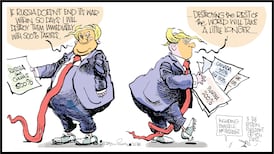ONE OF Aesop’s fables tells the story of a crow who quenches his thirst by filling a nearly empty pitcher with stones until the water level rises high enough to drink. And that rooks can also demonstrate this remarkable feat of causal reasoning has been demonstrated by scientists. Parrots, notably the African Grey, have extraordinary verbal skills, while Scrub jays, which hide caches of seeds and other food, have remarkable memories.
Hill Mynas are renowned for their ability to mimic the human voice, magpies can recognise themselves in mirrors. Many birds also demonstrate simple tool use – crows in urban Japan have learned to crack hard-shelled nuts by dropping them on to crossroads and letting them be run over and cracked by cars.
And what of mathematical ability? Surely stretching the ingenuity and intelligence of the avian species? Well, not so, apparently. Take cormorants on China's river Li. Rewarded by fishermen for their catches with every eighth fish, they have an uncanny ability to keep track of their due. A report in the Biological Journal of the Linnean Societyrecorded that once their quota of seven fish was filled, the birds "stubbornly refuse to move again until their neck ring is loosened. They ignore an order to dive and even resist a rough push or a knock, sitting glum and motionless on their perches". Other birds that had not filled their quotas continued to catch fish.
Now the humble, underrated pigeon – for many, unfortunately, just a “rat with wings” – is being credited with even more subtle skills. Pigeons have now been shown to be able to learn abstract rules about numbers, an ability that had been demonstrated previously only in primates, notably rhesus monkeys (and man – or some of us – of course). A study in the latest Science reports that pigeons, after training, were able by pecking to rank varied groups of items on a computer screen by size from lowest to highest. The results “suggest that despite completely different brain organisation and hundreds of millions of years of evolutionary divergence, pigeons and monkeys solve this problem in a similar way”, says co-author Elizabeth Brannon of Duke University.
It’s not technically “counting” – the pigeons did not have a specific tag for each number – but a form of numerical problem-solving. But one Harvard researcher can go one better. She worked with a grey parrot called Alex that actually did count and could indicate which of two Arabic numbers was larger or smaller. He indicated his choices in English.
Bird-brained, indeed.










